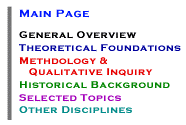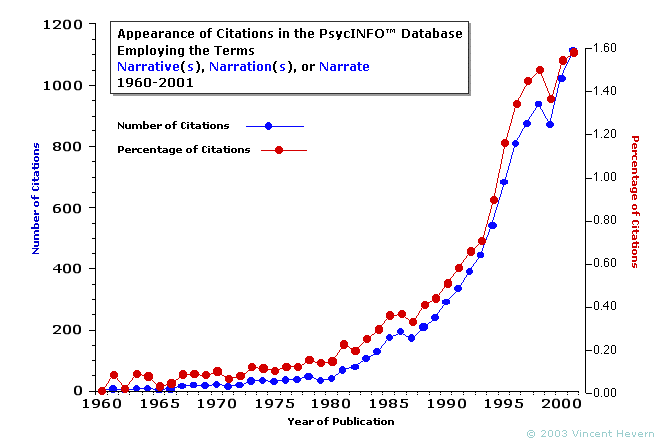
Last updated: March 3, 2004
![]()
General
Overview
Introduction and
General Overview
|
Last updated: March 3, 2004 |
|
This guide provides a broad set of bibliographical and Internet-based resources for use in the study of narrative psychology and has been designed both as an Internet-available document for researchers generally and partially to be used within both an advanced undergraduate psychology and graduate-level seminar.
For the past two decades, psychologists have been turning toward the notion of narrative with clearly accelerating intensity in order to establish a new "paradigm" or "root metaphor" (as Theodore Sarbin [1986] terms it) for the scholarly discipline of psychology. They have examined other fields of scholarship to borrow or adapt concepts and notions about narrative and stand indebted to literary theorists, philosophers, historians, theologians, anthropologists, sociologists, and scholars of women's, gay/lesbian, and ethnic studies for a great deal of the foundation upon which narrative perspective in psychology is being built.
Three analyses illustrates the development of a "narrative turn" in both the social sciences and in psychology. In the first of these studies undertaken in June, 1997, I first examined the accumulated bibliographical records in the computerized database relating to narrative psychology which I had been accumulating for the previous four years. This collection of items comprised slightly over 2650 scholarly articles, book chapters and full texts as well as doctoral dissertations. These extend back to the 1895 work by Mabel W. Learoyd, Maude L. Taylor, and Mary Whiton Clakins* at Wellesley College on the association of longer narratives and the experience of synesthesia (unusual and mixed preception of sights and sounds) and William Stern's methodological considerations of individual testimony and the psychology of individuality in 1910**. The vast majority of these references, however, appeared only following the 1950s. To clarify the development of the interest in narrative and discourse, I then undertook a comprehensive search of PsycINFO™ and Dissertation Abstracts Online for the period 1979 through 1995 (see Note A) to identify recently published scholarly materials which contained the keywords or subject descriptors of narrative and life history, narrative and psychology (or psychological), storytelling and psychology (or psychological), or discourse analysis. The references uncovered in this search were stored for analysis as an EndNote 2.0 database after duplicate references were discarded. The distribution of the dates of publication of individual references retrieved in this second search is illustrated below in Table 1.
As this table illustrates, the post-1984 interest in narrative issues across psychology, the social sciences, and related-disciplines had been rising at an almost exponential rate and showed little evidence of ebbing. [Note: this table is reproduced in Lieblich, Tuval-Mashiach, and Zilber (1998; see *** below for full citation).]
A third analysis was undertaken in the PsycINFO™ database in July, 2003 to get a better sense of the context and any subsequent trend following 1995. The generic search term "narrat*" was used to retrieve citations in which the terms "narrative, narratives, narration, narrations," or "narrate" appeared anywhere in the online item record. The results of this search are illustrated in Table 2 and confirm the trends which were seen in the earlier and more limited analysis for 1979-1995: (1) there was a distinctive and accelerating interest in narrative by psychology and other social science researchers in the last part of the 20th century which (2) began to gather strength among psychologists during the 1980s.

It might be objected that the growth in absolute numbers of articles might be accounted in some part by the accelerating rate of publication of psychological research literature more generally over the past forty years. However, as Table 2 further demonstrates, the rise in the psychological literature broadly involving narrative also shows an absolute growth during this period. As a percentage of all citations in the PsycINFO™ database, those concerned with narrative rise from an average of 0.058% during 1960-1964 to 1.49% during 1997-2001, a comparative growth of 2569%. Table 2 also confirms that the development I first described in 1997 -- an expansion of concern with narrative at a quasi-exponential rate in the previous decade -- has continued over the subsequent half-decade. Indeed, the interest in narrative has actually accelerated appreciably in the period since 1995, the reason(s) for which will warrant further attention by researchers in the years ahead. Parenthetically, I am reminded of an important narrative researcher who recently attended the annual meeting of a traditional psychological speciality discipline and returned to tell me "It felt like half the papers there called themselves 'narrative'." Or as the eminent narrativist Catherine Kohler Riessman (2002) recently put it, "Speaking as someone who has been working in the field for many years, even I am becoming uncomfortable with the popularity of the genre--the tyranny of the narrative as I call it elsewhere..." (p. 4).
In light of the extraordinary proliferation of research efforts in so many domains and subdomains which study human behavior, this guidebook offers an overview of the more important literature in narrative psychology itself as well as selected resources from other disciplines which can assist psychology students at both graduate and undergraduate levels to understand what narrative is all about. In his recent typological study of narrative, Harvard Medical School lecturer Elliot Mishler (1995) claimed that "I do not believe the study of narrative is a separate and distinctive discipline as some have proposed, calling it narratology. Rather, I view it as a problem-centered area of inquiry. From that perspective, it will always include a multiplicity and diversity of approaches" (p. 88). The material in this compendium acknowledges just how broad and diverse those approaches can be. I further hope this guide echoes something of the judgment made by Jerome Bruner in his "Forward" to anthropologist Bradd Shore's (1996) Culture in Mind: Cognition, Culture, and the Problem of Meaning: a too-ready separation of scholarly disciplines such as occured between psychology and anthropology "must surely be counted as one of the most stunting developments in the history of the human sciences" (p. xiii).Overview of Guide
Each topic in this guide is given its own subpage. These subpages are constituted by a coordinated set of resources which may include some or all of the following elements:
- a summary of the background issues which inform scholarly discussion of the topic;
- Internet-based resources, if any, dealing with the topic;
- Print-based bibliographical resources, many annotated, which permit a student of narrative to begin study of that topic; and,
- A listing of key figures and theorists who have made major contributions to the topic.
A concerted (and renewed) effort began in June, 2003 to construct a sort of master guide to influential theorists and key figures across the narrative disciplines and its cognate fields of study. It will probably take between 12 and 18 months to complete this bio-bibliographical guide with an appropriate degree of completeness.
Some Technical Comments Constuction. When the World Wide Web first appeared, academic and other internet authors often warn browsers that the page was "UNDER CONSTRUCTION". I originally followed that social practice at this site. Of course, the implied expectation of such a notice was that there would come a time when such pages had reached an end point or final form. I no longer believe that this is true. The resources in this guide are under the steady "construction" of revision and addition all the time. So, I will generally desist from using "UNDER CONSTRUCTION" warnings. Rather, browsers will find that every page at this site is dated to indicate the last time it was changed by me.
Formattting. The references herein now follow APA (5th Edition) style as far as possible. However, the use of Hypertext Markup Language [HTML] as the medium of dissemination currently precludes slavish adherence to APA's formatting strictures. In particular, "APA 5th Edition" now prescribes the use of italics for the titles of references. However, as many Internet design editors have pointed out, italic print looks particuarly ugly and is considered by many difficult to read when employed extensively. So, I will generally substitute bold face type for italics in the titles of most resources in this guide.
Note of Appreciation. Preparation of this guide was originally supported in part by a 1995 and a 1997 Summer Development grant from the Le Moyne College Faculty Senate Research and Development Committee to whom I remain most grateful.
Corrections. Errors in the text are, of course, my responsibility and I would be grateful for such mistakes to brought to my attention for correction. I have written many of the annotations below on the basis of my own reading of the item or, in certain cases, as a summary of an item's abstract recovered from various commercial and other databases. I have occasionally employed particularly apt summaries derived from publisher's blurbs which tend to appear online at publisher websites; these materials have been used under the copyright exemption for brief materials quoted in the context of a review. All materials taken from sources other than my own composition are enclosed in quotes and a brief notice of their origin is made. I have sought to eliminate any other materials from this text which may be under copyright; I will remove any further copyrighted text which, in error, might remain in these pages if brought to my attention.
* Learoyd, M. W., Taylor, M. L., & Calkins, M. W. (1895). Minor studies form the psychological laboratory of Wellesley College: The `continued story'; Synaesthesia. American Journal of Psychology, 7(1 Oct), 86-107.
** Stern, W. (1910). Abstracts of lectures on the psychology of testimony and on the study of individuality. American Journal of Psychology, 21(2 Apr), 270-282.
*** Lieblich, A., Tuval-Mashiach, R., & Zilber, T. (1998). Narrative research: Reading, analysis and interpretation. Thousand Oaks, CA: Sage, p. 4.
Riessman, C. K. (2002, May). Illness narratives: Positioned identities. Paper given at the Health Communication Research Centre, Cardiff University, Wales, UK. Downloaded March 3, 2004 from the Cardiff University website: http://www.cf.ac.uk/encap/hcrc/comet/prog/narratives.pdf
Note A. I stopped my analysis at the year 1995 presuming that the PsycINFO™ database would still be cataloguing materials from 1996 at the time I retrieved these data and would therefore be incomplete for 1996. The same reasoning applied to the second set of data reported further below which stops at 2001 since it was collected in July, 2003 and the cataloguing of the 2002 literature continues in progress.
|
||
|
Narrative Psychology: Internet and Resource Guide
|